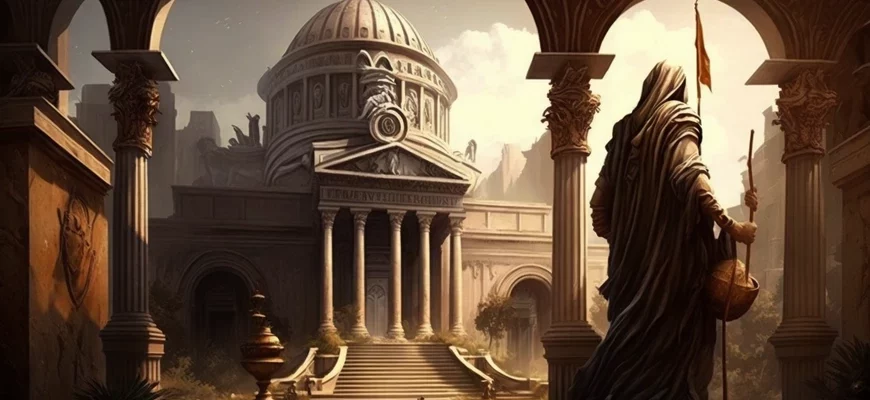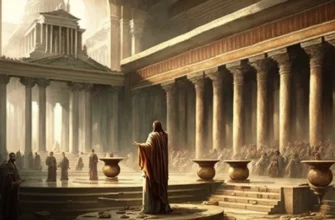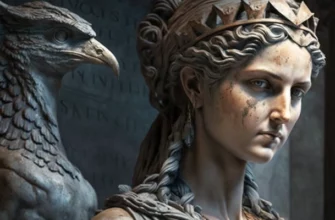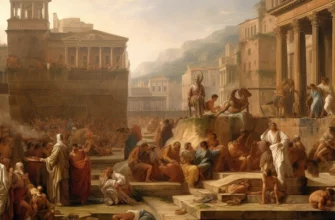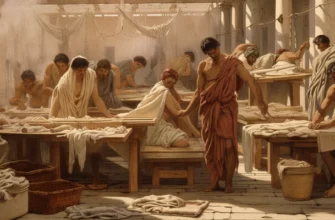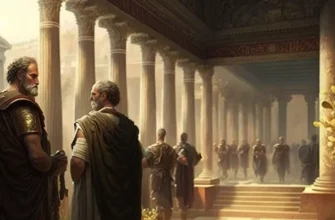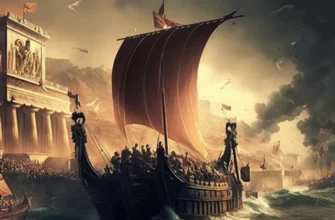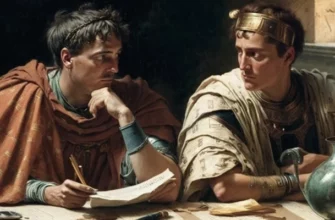The religion of ancient Rome has a rich history and influenced the culture and art of the Roman Empire. The Romans believed in a pantheon of deities who ruled over various aspects of life. Religious rituals and ceremonies were an important part of their lives. Although Roman religion declined with the adoption of Christianity, its influence remained and is still reflected in the culture and art of the modern world.
Roman religious system
The Roman religious system included many deities that reflected different aspects of life and nature. Each deity had its own characteristics and responsibilities and was often associated with specific events or animals. The Romans believed in the afterlife and honored their ancestors. Religious rituals and ceremonies included sacrifices, public prayers, and rites. Roman religion was an important element of the culture and art of the Roman Empire.
Deities
Ancient Rome had a large number of deities that represented different aspects of life. Some of the most famous deities were Jupiter, Neptune, Mercury, Mars, Venus, and Diana. Jupiter was the chief deity and protector of Rome. Neptune was the god of the seas and waters, Mercury was the god of trade and commerce, and Mars was the god of war. Venus was the goddess of beauty and love, and Diana was the goddess of nature and hunting. Each deity had its own characteristics and responsibilities and was depicted with specific attributes and symbols.
Religious rituals and ceremonies
Religious rituals and ceremonies were an important part of life in ancient Rome. Sacrifices, public prayers, and ceremonies were performed to please the deities and gain their support. The Romans also believed in the afterlife and performed rituals related to burial and honoring their ancestors. Some religious festivals were celebrated to mark the harvest, the changing of the seasons, or to honor specific deities. For example, the Festival of Quirinus was celebrated in honor of Mars, and the Bacchanalia were celebrations in honor of the goddess Venus.
Sacrifices
Sacrifices were an important part of religious practice in ancient Rome. They were a way of fulfilling religious duties and ensuring the favor of the deities. Sacrifices could take various forms, depending on the purpose and the deity. Sometimes cattle, birds, fish, or fruit were offered, and sometimes wine or monetary donations. Sacrifices took place in specially designated places, such as streets or open spaces. Some sacrifices were performed to atone for sins or to ask the deities for forgiveness.
Beliefs about the afterlife
The ancient Romans believed in an afterlife where the souls of the dead resided after death. They believed that the soul retained consciousness and the ability to act after death, and therefore good and deserving people could be rewarded, while evil and sinful people could be punished. The Romans performed rituals and sacrifices in honor of the dead, believed in the existence of hell and paradise, and placed images of the deceased on their graves in the hope that this would help their souls in the afterlife. Beliefs about the afterlife had a great influence on the religious culture and everyday life of the ancient Romans.
Religion and culture
Religion was not only a part of ancient Roman culture, but also determined their way of life and social structure. The Romans believed that the gods influenced all areas of life, from agriculture and military campaigns to family life and politics. They created special shrines and places of sacrifice, which were the center of religious life.
The culture of ancient Rome was also strongly linked to religion. Roman literature, art, and architecture contained numerous religious symbols and motifs. For example, gods and goddesses were often depicted on arches, colonnades, and sculptures, and Roman literature contained numerous myths and legends about deities. In addition, religious festivals were important cultural events that brought Romans together and included art exhibitions, theatrical performances, and other forms of entertainment.
The influence of religion on art
Religion had a major influence on the art of ancient Rome, and most works of art were dedicated to gods and religious themes. The architecture of Roman buildings, such as temples and amphitheaters, was very influential, and the Romans carefully chose decorative elements that symbolized their beliefs. Sculpture was also an important art form, and many sculptures depicted gods and heroes from Roman mythology.
Religious themes were also popular in Roman painting, which often depicted scenes from mythology or religious rituals. Many works of art in ancient Rome, such as mosaics and frescoes, were decorated with images of gods and heroes.
Thus, the religion of ancient Rome influenced art and became an important part of its cultural heritage. Art helped the ancient Romans to recreate their beliefs and immortalize their religious traditions for future generations.
Religion and politics
Religion and politics in ancient Rome were closely linked. The Romans believed in polytheism, so religion played an important role in their lives and culture. Rome had a state religion that was associated with the emperor and state institutions.
In ancient Rome, there were many deities, each responsible for a specific aspect of life. The gods and goddesses represented various phenomena, such as war, love, fertility, wisdom, art, and more. The Romans had a very strong belief in rituals and ceremonies, which helped to maintain the community and ensure favorable conditions for life.
Politics was also an important part of Roman life. Rome had a monarchy, a republic, and an empire, and each of these regimes had an impact on religion and culture. For example, the republic had a very strong system of consuls and senators who influenced the state religion and controlled religious ceremonies.
During the empire, the emperor became the center of state religion and culture. A cult of personality around the emperor was introduced, and religious ceremonies and rituals were linked to his image and power. This was linked to the desire to govern and control the population through religion.
In general, religion and politics were inextricably linked in ancient Rome, and they influenced each other in many aspects of Roman life.
The decline of Roman religion
The decline of Roman religion in ancient Rome was linked to several factors. First, with the spread of Christianity, which eventually became the dominant religion in the Roman Empire. Christianity began to spread in Rome at the beginning of the first century AD, but was persecuted by the authorities. However, in the fourth century, Christianity became legal and influenced the decline of Roman religion.
Second, the decline of Roman religion was linked to the development of science and philosophy, which began to replace mythology and religious beliefs. In particular, the philosophies of Stoicism and Epicureanism began to change the religious views of many Romans.
Third, the decline of Roman religion was linked to changes in the political and social life of the Roman Empire. In particular, during the period of the empire’s collapse, when power was fragmented and state institutions lost their influence, religious beliefs also began to decline.
Finally, the decline of Roman religion was linked to changes in culture and art. Roman art and architecture were changing, and religious ceremonies and rituals were becoming less important to people.
All of these factors contributed to the decline of Roman religion, but it still remained an important part of Roman culture and life until the end of the Western Roman Empire in the fifth century CE. Even after Christianity became the official religion of the Roman Empire in 380, many traditions and rituals still remained in use. However, over time, the Christian church grew stronger and changed the religious landscape of Rome.
One of the most famous cases of the destruction of shrines and symbols was the campaign led by Empress Theodora in the sixth century. She actively fought against cults and traditions, ordering the destruction of shrines and their conversion into Christian churches.
Another important factor in the decline of Roman religion was the change in economic and social conditions. The western part of the Roman Empire experienced a decline in economic activity and population, which led to the decline of cities and villages. These changes caused a shift in beliefs and led to a decline in interest in religion.
At the end of the fifth century, the Roman Empire was conquered by barbarians, which led to the end of ancient Roman religion and culture. However, certain Roman traditions and rituals have been preserved in the Christian church and culture and have influenced our modern religious traditions.
Christianity in the Roman Empire
Christianity appeared in the Roman Empire in the first centuries AD, but until the third century it was quite small in number and was met with hostility and persecution by the Roman authorities. However, after Emperor Constantine the Great converted to Christianity in the fourth century, Christianity became the official religion of the Roman Empire in 380.
One of the advantages of Christianity was that it was open to everyone, regardless of their social position or nationality. This contributed to the spread of Christianity throughout the Roman Empire. In addition, Christian ideals such as mercy, love for one’s neighbor, and responsibility before God differed from the beliefs of Rome, which ensured the success of the religion among the population.
In the following centuries, the Christian church grew stronger and became the main religion of the Roman Empire. This allowed it to influence the politics and social life of Rome. Christianity influenced legislation, culture, art, and science, and became one of the most influential religions in the world.
However, the strengthening of Christianity also caused conflicts and divisions between Christian groups. For example, the split between Orthodox and Catholic Christianity occurred in 1054, leading to the formation of two separate churches.
In addition, the sixth century saw the iconoclastic crisis, which caused a schism between the Orthodox and Catholic churches in the East. At the same time, new religious movements began to emerge in the West, such as Protestantism, which spread throughout Europe during the Reformation in the 16th century.
Gradually, the religious influence on politics and social life in the Roman Empire began to decline. In 476, the Roman Empire split into eastern and western parts, with the eastern part retaining its Christian orientation, while the western part, known as the Western Roman Empire, suffered invasions and destruction by barbarian peoples.
In the Middle Ages, religious authority became the basis for the organization of society and government in most European countries. However, since the beginning of the modern era and the development of science and enlightenment, religion has become less influential in society. Since the beginning of the 20th century, many countries have become secular, religion has become a more private matter, and political power is no longer linked to religion.
Conclusions
Religion was extremely important in ancient Rome; it was not just a system of beliefs and rituals, but also an important component of the social structure and political power. The Romans believed in many gods and goddesses, each of whom had their own functions and responsibilities. Religious rituals were associated with all areas of life, from birth and marriage to military activity and death.
However, over time, religious influence began to decline, particularly after the spread of Christianity. Christianity played an important role in the history of the Roman Empire, as it became the dominant religion and changed the influence of religion on politics and social life. In addition, the development of science and education in the modern era reduced the religious influence on society.
Nevertheless, the legacy of ancient Roman religion remains in the history and culture of the modern world. Many concepts that originated in ancient Rome, such as “republic,” “senate,” “villa,” “amphitheater,” and “catacombs,” are used in modern language. In addition, the rituals and symbols of the Christian religion remain an important part of the culture of many countries around the world.
Thus, the religion of ancient Rome had a great influence on the society and politics of its time, but over time its influence diminished, while its legacy remained in the culture and history of the modern world.
